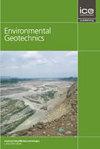美国加利福尼亚州蒙特西托市山火后泥石流:一个案例研究和基于经验的泥石流体积估算
IF 2.2
4区 工程技术
Q3 ENGINEERING, GEOLOGICAL
引用次数: 0
摘要
野火对土壤和沉积物的各种岩土和水力特性产生强烈影响,可能使其更容易受到滑坡或泥石流的影响。本研究以2018年美国加利福尼亚州蒙特西托(Montecito)野火后泥石流为例,重点研究野火影响区域和泥石流体积估算。2018年1月,也就是托马斯大火发生一个月后,在蒙特西托溪、圣伊西德罗溪、布埃纳维斯塔溪和罗梅罗溪等4条主要小溪周围堆积了大量碎片。利用遥感技术和地理信息系统(GIS)数据分析卫星图像,以确定受野火影响的地区。利用坡度、集水区面积和降雨量等相关数据,建立了两个经验模型,估算了四条小溪周围的碎屑体积。与现场观测结果相比,这些经验模型估算的每个碎片体积在同一数量级内。当使用蒙特西托气象站记录的降雨量时,碎片体积通常被低估了;根据道尔顿隧道站的雨量记录,估计结果有很大改善。结果表明,总的来说,这种经验方法仍然有利于工程实践,因为它们能够提供一阶近似。降雨数据的准确性和可用性是关键因素;山区的降雨数据普遍高于低地,因此更适合本研究中泥石流体积的估算,其中泥石流通常发生在陡坡和高海拔地区。本文章由计算机程序翻译,如有差异,请以英文原文为准。
Post-Wildfire Debris Flows in Montecito, California (USA): A Case Study and Empirically Based Debris Volume Estimation
Wildfires have a strong influence on various geotechnical and hydraulic properties of soils and sediments, which may become more vulnerable to landslides or debris flows. In the present study, a case investigation of the 2018 post-wildfire debris flows in Montecito, California, USA, was conducted, with a focus on the wildfire-affected areas and debris volume estimation. Significant debris were deposited around four major creeks, i.e., Montecito Creek, San Ysidro Creek, Buena Vista Creek, and Romero Creek in January, 2018, one month after the Thomas fire. Satellite images utilizing remote sensing techniques and geographic information system (GIS) data were analyzed to identify areas affected by the wildfire. Relevant data, including the slope, catchment area, and rainfall were used in two empirical models to estimate the debris volumes around the four creeks. As compared with field observation, each debris volume estimated with these empirical models was within the same order of magnitude. The debris volumes were generally underestimated when using the rainfall recorded at the Montecito Weather Station; the estimates considerably improved with the rainfall record from the Doulton Tunnel Station. The results showed that, overall, such empirical approaches are still of benefit for engineering practice, as they are capable of offering first-order approximations. The accuracy and availability of rainfall data are critical factors; the rainfall data in mountainous areas are generally higher than in the low lands, and consequently were more suitable for debris volume estimation in the present study, where the debris flows typically occurred in areas with steep slopes and at higher elevations.
求助全文
通过发布文献求助,成功后即可免费获取论文全文。
去求助
来源期刊

Environmental geotechnics
Environmental Science-Water Science and Technology
CiteScore
6.20
自引率
18.20%
发文量
53
期刊介绍:
In 21st century living, engineers and researchers need to deal with growing problems related to climate change, oil and water storage, handling, storage and disposal of toxic and hazardous wastes, remediation of contaminated sites, sustainable development and energy derived from the ground.
Environmental Geotechnics aims to disseminate knowledge and provides a fresh perspective regarding the basic concepts, theory, techniques and field applicability of innovative testing and analysis methodologies and engineering practices in geoenvironmental engineering.
The journal''s Editor in Chief is a Member of the Committee on Publication Ethics.
All relevant papers are carefully considered, vetted by a distinguished team of international experts and rapidly published. Full research papers, short communications and comprehensive review articles are published under the following broad subject categories:
geochemistry and geohydrology,
soil and rock physics, biological processes in soil, soil-atmosphere interaction,
electrical, electromagnetic and thermal characteristics of porous media,
waste management, utilization of wastes, multiphase science, landslide wasting,
soil and water conservation,
sensor development and applications,
the impact of climatic changes on geoenvironmental, geothermal/ground-source energy, carbon sequestration, oil and gas extraction techniques,
uncertainty, reliability and risk, monitoring and forensic geotechnics.
 求助内容:
求助内容: 应助结果提醒方式:
应助结果提醒方式:


